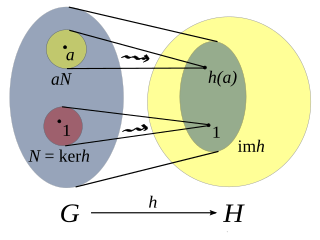Related Research Articles

In mathematics, given two groups, and, a group homomorphism from to is a function h : G → H such that for all u and v in G it holds that
In algebra, a homomorphism is a structure-preserving map between two algebraic structures of the same type. The word homomorphism comes from the Ancient Greek language: ὁμός meaning "same" and μορφή meaning "form" or "shape". However, the word was apparently introduced to mathematics due to a (mis)translation of German ähnlich meaning "similar" to ὁμός meaning "same". The term "homomorphism" appeared as early as 1892, when it was attributed to the German mathematician Felix Klein (1849–1925).
In mathematics, more specifically in the area of abstract algebra known as ring theory, a Noetherian ring is a ring that satisfies the ascending chain condition on left and right ideals; that is, given any increasing sequence of left ideals:
In category theory, an epimorphism is a morphism f : X → Y that is right-cancellative in the sense that, for all objects Z and all morphisms g1, g2: Y → Z,
In mathematics, especially homological algebra and other applications of abelian category theory, the five lemma is an important and widely used lemma about commutative diagrams. The five lemma is not only valid for abelian categories but also works in the category of groups, for example.
Ring theory is the branch of mathematics in which rings are studied: that is, structures supporting both an addition and a multiplication operation. This is a glossary of some terms of the subject.
In mathematics, particularly in algebra, the class of projective modules enlarges the class of free modules over a ring, by keeping some of the main properties of free modules. Various equivalent characterizations of these modules appear below.
In abstract algebra, a branch of mathematics, a simple ring is a non-zero ring that has no two-sided ideal besides the zero ideal and itself. In particular, a commutative ring is a simple ring if and only if it is a field.
In mathematics, especially in the area of abstract algebra known as module theory, an injective module is a module Q that shares certain desirable properties with the Z-module Q of all rational numbers. Specifically, if Q is a submodule of some other module, then it is already a direct summand of that module; also, given a submodule of a module Y, then any module homomorphism from this submodule to Q can be extended to a homomorphism from all of Y to Q. This concept is dual to that of projective modules. Injective modules were introduced in and are discussed in some detail in the textbook.
In algebra, a module homomorphism is a function between modules that preserves the module structures. Explicitly, if M and N are left modules over a ring R, then a function is called an R-module homomorphism or an R-linear map if for any x, y in M and r in R,
In algebra, a flat module over a ring R is an R-module M such that taking the tensor product over R with M preserves exact sequences. A module is faithfully flat if taking the tensor product with a sequence produces an exact sequence if and only if the original sequence is exact.
In mathematics, particularly in algebra, the injective hull of a module is both the smallest injective module containing it and the largest essential extension of it. Injective hulls were first described in.
In mathematics, sheaf cohomology is the application of homological algebra to analyze the global sections of a sheaf on a topological space. Broadly speaking, sheaf cohomology describes the obstructions to solving a geometric problem globally when it can be solved locally. The central work for the study of sheaf cohomology is Grothendieck's 1957 Tôhoku paper.
In mathematics, injective sheaves of abelian groups are used to construct the resolutions needed to define sheaf cohomology.
In the branch of abstract mathematics called category theory, a projective cover of an object X is in a sense the best approximation of X by a projective object P. Projective covers are the dual of injective envelopes.
In mathematics, and more specifically in homological algebra, a resolution is an exact sequence of modules, which is used to define invariants characterizing the structure of a specific module or object of this category. When, as usually, arrows are oriented to the right, the sequence is supposed to be infinite to the left for (left) resolutions, and to the right for right resolutions. However, a finite resolution is one where only finitely many of the objects in the sequence are non-zero; it is usually represented by a finite exact sequence in which the leftmost object or the rightmost object is the zero-object.
In abstract algebra, a cover is one instance of some mathematical structure mapping onto another instance, such as a group (trivially) covering a subgroup. This should not be confused with the concept of a cover in topology.
Module theory is the branch of mathematics in which modules are studied. This is a glossary of some terms of the subject.
In algebra, Auslander–Reiten theory studies the representation theory of Artinian rings using techniques such as Auslander–Reiten sequences and Auslander–Reiten quivers. Auslander–Reiten theory was introduced by Maurice Auslander and Idun Reiten (1975) and developed by them in several subsequent papers.
This is a glossary of commutative algebra.
References
- Enochs, Edgar E. (1981), "Injective and flat covers, envelopes and resolvents", Israel Journal of Mathematics , 39 (3): 189–209, doi: 10.1007/BF02760849 , ISSN 0021-2172, MR 0636889
- Bican, L.; El Bashir, R.; Enochs, E. (2001), "All modules have flat covers", Bulletin of the London Mathematical Society, 33 (4): 385–390, doi:10.1017/S0024609301008104, ISSN 0024-6093, MR 1832549
- "Flat cover", Encyclopedia of Mathematics , EMS Press, 2001 [1994]
- Xu, Jinzhong (1996), Flat covers of modules , Lecture Notes in Mathematics, 1634, Berlin: Springer-Verlag, doi: 10.1007/BFb0094173 , ISBN 3-540-61640-3, MR 1438789